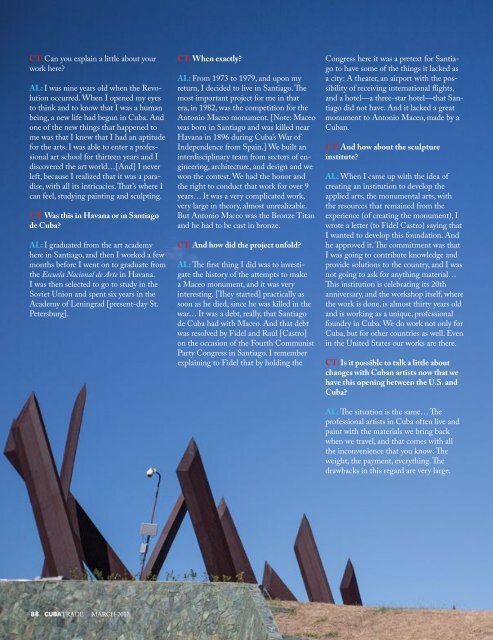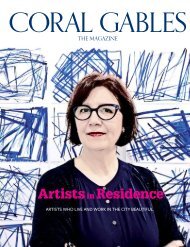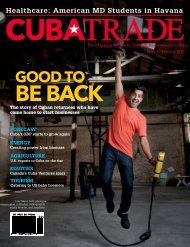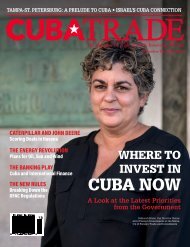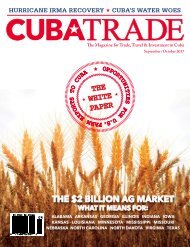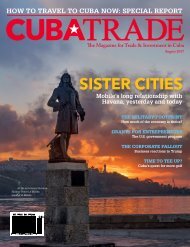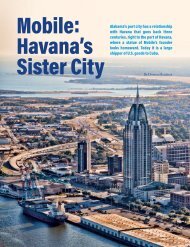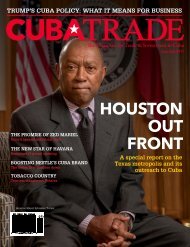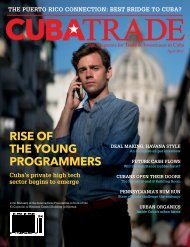Create successful ePaper yourself
Turn your PDF publications into a flip-book with our unique Google optimized e-Paper software.
CT: Can you explain a little about your<br />
work here?<br />
AL: I was nine years old when the Revolution<br />
occurred. When I opened my eyes<br />
to think and to know that I was a human<br />
being, a new life had begun in Cuba. And<br />
one of the new things that happened to<br />
me was that I knew that I had an aptitude<br />
for the arts. I was able to enter a professional<br />
art school for thirteen years and I<br />
discovered the art world…[And] I never<br />
left, because I realized that it was a paradise,<br />
with all its intricacies. That’s where I<br />
can feel, studying painting and sculpting.<br />
CT: Was this in Havana or in Santiago<br />
de Cuba?<br />
AL: I graduated from the art academy<br />
here in Santiago, and then I worked a few<br />
months before I went on to graduate from<br />
the Escuela Nacional de Arte in Havana.<br />
I was then selected to go to study in the<br />
Soviet Union and spent six years in the<br />
Academy of Leningrad [present-day St.<br />
Petersburg].<br />
CT: When exactly?<br />
AL: From 1973 to 1979, and upon my<br />
return, I decided to live in Santiago. The<br />
most important project for me in that<br />
era, in 1982, was the competition for the<br />
Antonio Maceo monument. [Note: Maceo<br />
was born in Santiago and was killed near<br />
Havana in 1896 during Cuba’s War of<br />
Independence from Spain.] We built an<br />
interdisciplinary team from sectors of engineering,<br />
architecture, and design and we<br />
won the contest. We had the honor and<br />
the right to conduct that work for over 9<br />
years… It was a very complicated work,<br />
very large in theory, almost unrealizable.<br />
But Antonio Maceo was the Bronze Titan<br />
and he had to be cast in bronze.<br />
CT: And how did the project unfold?<br />
AL: The first thing I did was to investigate<br />
the history of the attempts to make<br />
a Maceo monument, and it was very<br />
interesting. [They started] practically as<br />
soon as he died, since he was killed in the<br />
war… It was a debt, really, that Santiago<br />
de Cuba had with Maceo. And that debt<br />
was resolved by Fidel and Raúl [Castro]<br />
on the occasion of the Fourth Communist<br />
Party Congress in Santiago. I remember<br />
explaining to Fidel that by holding the<br />
Congress here it was a pretext for Santiago<br />
to have some of the things it lacked as<br />
a city: A theater, an airport with the possibility<br />
of receiving international flights,<br />
and a hotel—a three-star hotel—that Santiago<br />
did not have. And it lacked a great<br />
monument to Antonio Maceo, made by a<br />
Cuban.<br />
CT: And how about the sculpture<br />
institute?<br />
AL: When I came up with the idea of <br />
creating an institution to develop the<br />
applied arts, the monumental arts, with<br />
the resources that remained from the<br />
experience (of creating the monument), I<br />
wrote a letter (to Fidel Castro) saying that<br />
I wanted to develop this foundation. And<br />
he approved it. The commitment was that<br />
I was going to contribute knowledge and<br />
provide solutions to the country, and I was<br />
not going to ask for anything material…<br />
This institution is celebrating its 20th<br />
anniversary, and the workshop itself, where<br />
the work is done, is almost thirty years old<br />
and is working as a unique, professional<br />
foundry in Cuba. We do work not only for<br />
Cuba, but for other countries as well. Even<br />
in the United States our works are there.<br />
CT: Is it possible to talk a little about<br />
changes with Cuban artists now that we<br />
have this opening between the U.S. and<br />
Cuba?<br />
AL: The situation is the same… The<br />
professional artists in Cuba often live and<br />
paint with the materials we bring back<br />
when we travel, and that comes with all<br />
the inconvenience that you know: The<br />
weight, the payment, everything. The<br />
drawbacks in this regard are very large.<br />
88 CUBATRADE MARCH 2017


